Phnom Tamao Wildlife Rescue Center Tour, Phnom Pehn, Cambodia
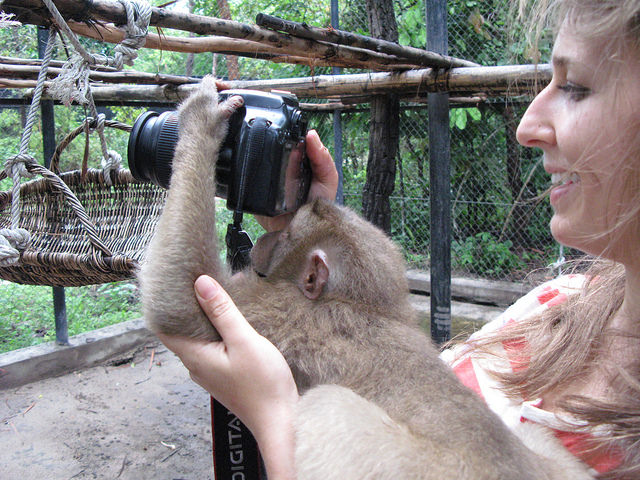
I think it was Nicci who found out about the Phnom Tamao Wildlife Rescue Center, and suggested that we go there. I would like to take credit, though. I think that it’s on par with discovering fire, or inventing the wheel, or figuring out that Junior Mints should be stored in the fridge. These are important developments in humanity’s history. I really want to be the one who made the whole petting-an-elephant thing possible for me and Nicci.

But getting credit is not the important part (she said to herself, unconvincingly). Nor was it petting the elephant (she said this even less convincingly. Seriously, who the fuck was she kidding?) No. The important part was that we got to support an international organization that is trying to make Southeast Asia a safer place for both animals and humans. (Yes.)
But also? I got to pet an elephant. (YES.)
In a perfect world, the Phnom Tamao Wildlife Rescue Center wouldn’t exist. Nor would Wildlife Alliance – the organization behind it. They wouldn’t be necessary; animals and humans would all coexist happily. Wasps wouldn’t bite, tigers would be free to roam around without fear of poaching, and there would be rainbows EVERYWHERE.
I suspect that poop collection would be a huge problem. Or maybe not. I’m talking about a perfect world, after all.
But that’s not the world in which we live. We live on a planet where animals are hunted to extinction, are mistreated and abused and mutilated. In that reality, Wildlife Alliance exists. And I’m glad they do.
Wildlife Alliance is a wildlife and environmental conservation organization that’s based in the U.S., but it operates in Cambodia. Like an over-achieving high school student, their interests cover many bases. They work in conjunction with Cambodian military police to combat illegal wildlife trade. They set up stings, intercept animals, and confiscate black market items (like snares and “potions” or aphrodisiacs that have been made from the carcasses of animals). They have been waging a battle against deforestation and illegal logging in Southeast Asia, while working to promote ecotourism and create alternative, environmentally-friendly jobs.
At their sanctuary, the Phnom Tamao Wildlife Rescue Center, which sits about an hour outside of Phnom Penh, they rehabilitate sick and injured animals (releasing them back into the wild when possible), and work to educate the public on issues of wildlife protection. It is not a perfect operation, something which they readily admit. Their finances are limited, and they have to operate within the confines of the Cambodian government, who can kick them out any time they damn well please. (For example, the Center wanted to prohibit visitors from feeding the animals, but the government insisted that they be allowed to. The compromise is that the Center has local vendors from the community come in and sell fruit and vegetables which can then be fed to the animals. The Center then monitors what is consumed to avoid overfeeding.)
But considering all of that, the Center (and the Alliance) manages to do some good, and provides for animals that would have likely died otherwise. Still, Nicci and I were wary. When you tell people that you’re going to visit a wildlife sanctuary in Asia, they tend to bristle. A lot of places are barely better than a cut-rate circus. But we read some reviews, and they were all glowing, so we decided to to visit.
Hell, we decided not to just visit, we decided to do the behind-the-scenes tour. We’d get a private guide, and have the opportunity to interact with several of the animals. It was $130 a person – a large sum to pay for anything in Southeast Asia but modest compared to prices we’d seen for other, similar tours.
Besides, the entire purchase price of our ticket went directly to the Center. It was hard to ignore that.
Emma, our guide, picked us up at around 8:00am from Phnom Pehn. She was originally from Australia, and the Wildlife Center’s first volunteer. During the hour long drive, we talked about how she first got started at the center and her life in Cambodia.
She was instantly likable – dreadlocked, pierced, and positively lovely. Outgoing, bright-eyed, and genuinely passionate about her work and the country she now called home.
Our first stop was at a small market to buy fresh fruit for the animals, and to pick up some water for us. Emma explained that she always used the same vendors, so they could count on her business.
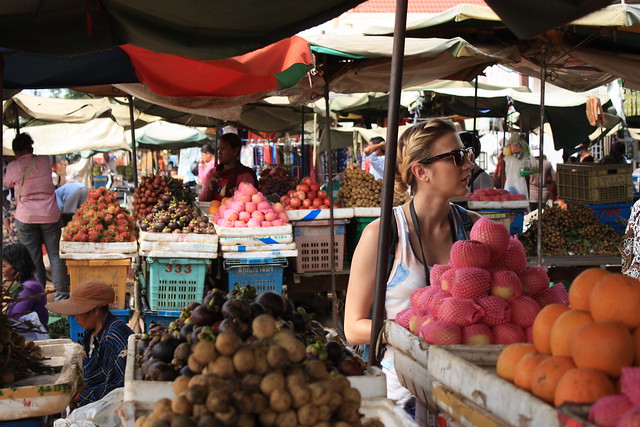

Nicci, lovely as always, at the market.
The drive up to the center was lined with older people in traditional Khmer dress, begging. Emma explained that they were local families. She said that many tourists were upset by the sight of them. We were just relieved that they weren’t kids, like we’d seen in Phnom Penh. We left Emma some cash to distribute amongst the families (apparently something that the Center often does).
And then we were there, and then there was Lucky.
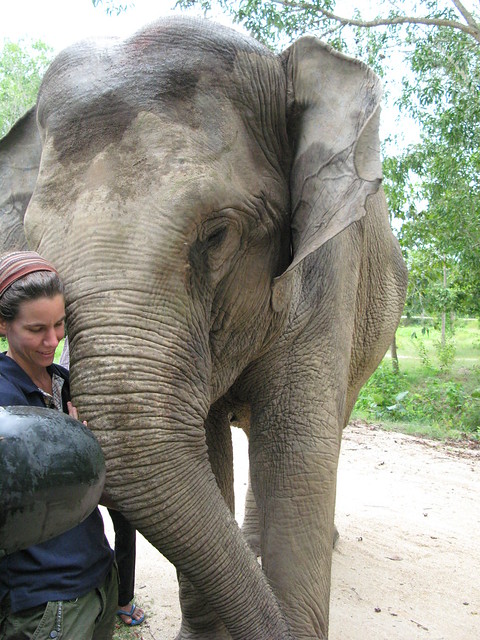
Emma getting some Lucky love.
Because I couldn’t resist, I wrote a whole post about her. In short – she was lovely and lively and felt like a friend. But she is not the only elephant at the rescue. There were four others. One of them, Chhouk, was rescued when he was around 2 years old. He’d been caught in a snare left by poachers, and his leg was badly injured (it’s believed that his mother stayed with him as long as she could, but eventually had to leave him when the herd moved on – a detail that breaks my heart).
The Center was able to save him, but not his leg. It’s been amputated just below the joint. Emma told us about how they struggled to find someone to make a prosthesis for Chhouk, but no one wanted to take on the task (the risk of it failing, and of gaining loads of bad PR scared many away). Eventually, they found an organization in Cambodia willing to do it.
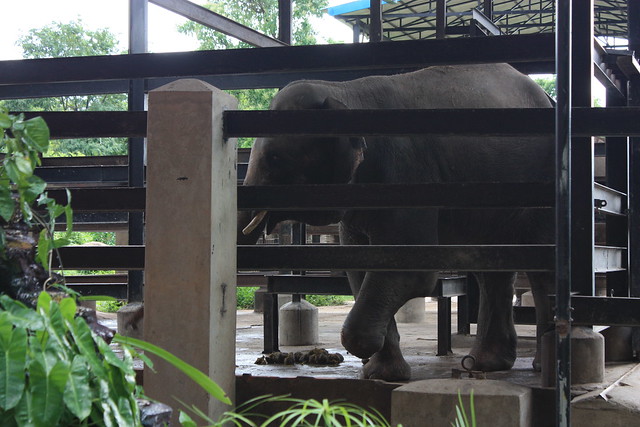
Emma explained that the first time Chhouk was fitted with his prosthetic leg, he took off running. He constantly needs new ones to accommodate his growing size.
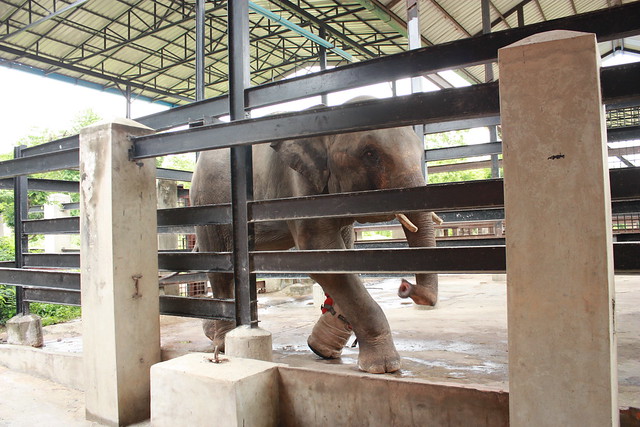
The bottom of his prosthesis is a Bridgestone Tire. It was the only material on-hand that was strong enough to support the wear-and-tear that Chhouk put on it. Apparently, when the folks at Bridgestone learned of this, they decided to sponsor his care.
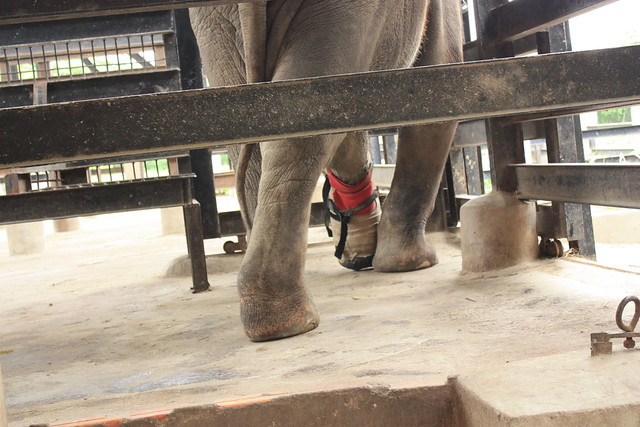
Emma led us to a few more enclosures. We wandered by the monkeys …
And spent some time with the tigers. Most of the ones at Wildlife Alliance were rescued from an illegal market – they were likely en route to China.

Emma explained that while these ones are capable of living in the wild, they can’t release them: poachers would nab them instantly (just one whisker from a male tiger can sell for $10,000). They do have access to a larger area earlier in the day, but in the afternoon and at night, they are locked in the more secure closure you see here.
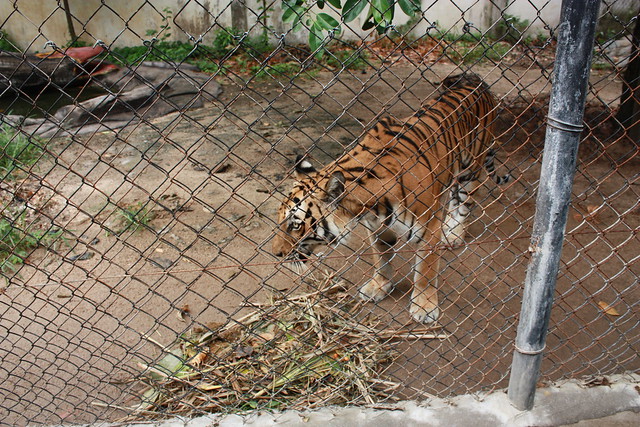
And yeah – all that separated us was a thin chain link fence.
We watched them interact with their caretaker (whose name escapes me at the moment). Emma explained that his relationship with the animals was a unique one – they adored him. And sure enough, we saw him reach into the pen to pet one of the tigers. It brushed up against him and purred like a kitten.
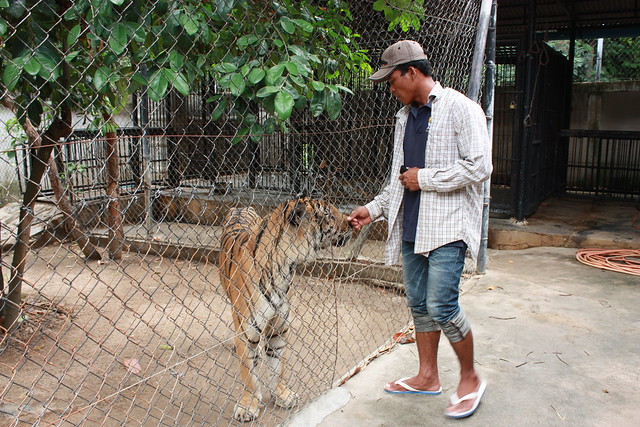
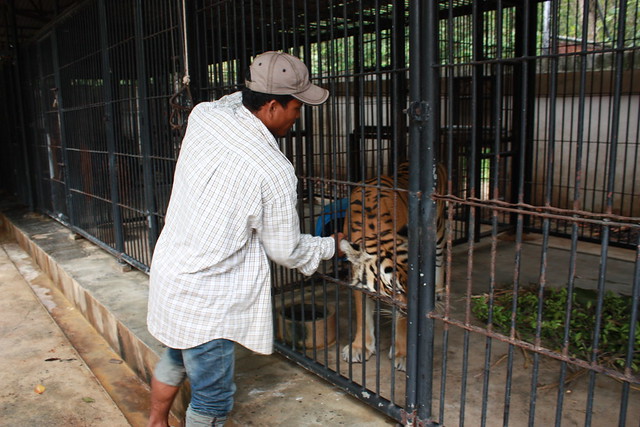
A very big, very loud kitten.
Nicci and I exchanged a wide-eyed, slack-jawed look. If you’ve never heard a tiger purr (and honestly, who has?), it sounds like the hum of a motorboat.
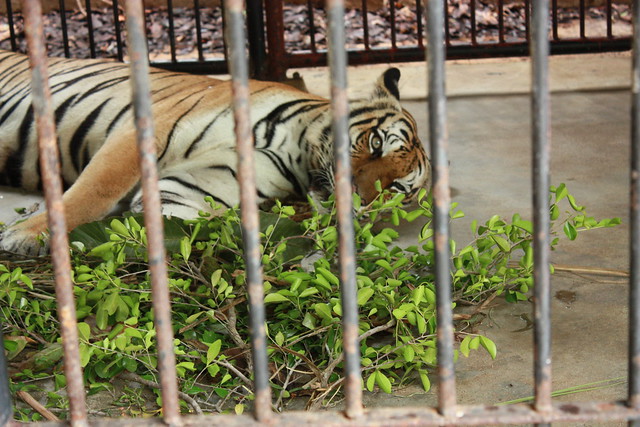
Then we stopped off to see the gibbons, which was quite terrifying for me. Especially when Emma showed us how we could pet them.
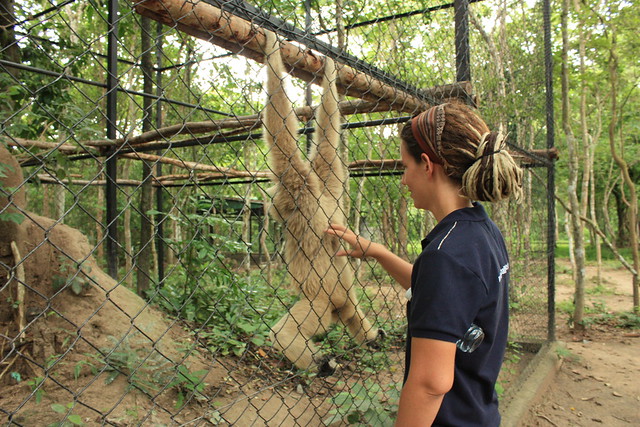
Apparently I’m totally okay with elephants and tigers, but apes is where I draw the line. Nicci wasn’t bothered by them at all. Hell, they even posed for her.
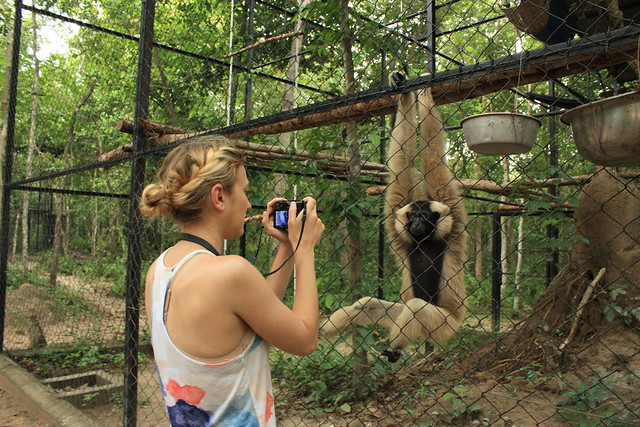
And then it was time for lunch. It had been threatening rain all morning, and by the time we made it to the picnic grounds, it had started to pour.
The tables at which we ate were built with this in mind – they were raised off the ground, to discourage rain and insects, and had a watertight roof.
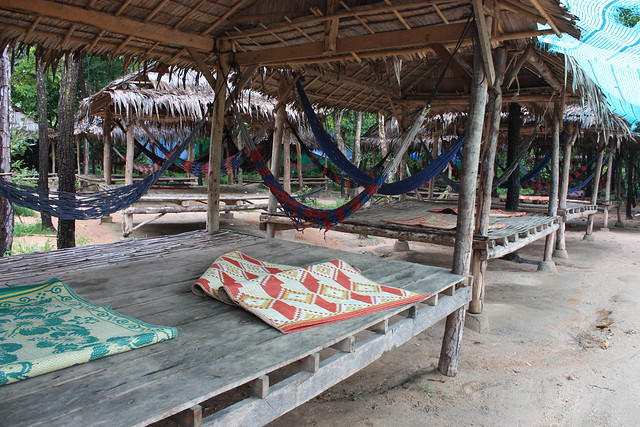
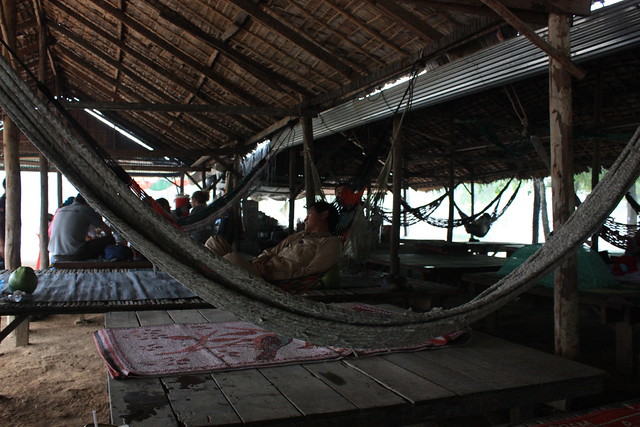
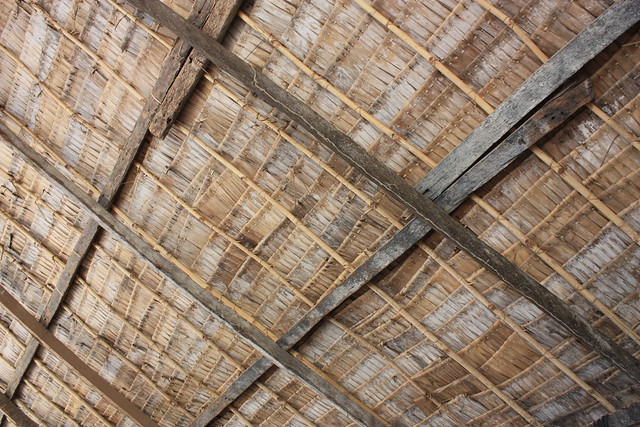
We sat and watched the rain and waited for lunch, talking about the day thus far. I travel plenty. Nicci is nothing if not mindful of the world around her. But this was new and entirely different, and we couldn’t help but laugh.
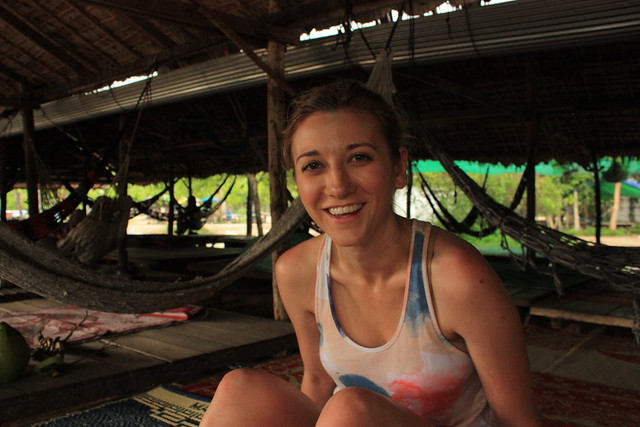
A man with a machete came by, and cut open some coconuts for us.
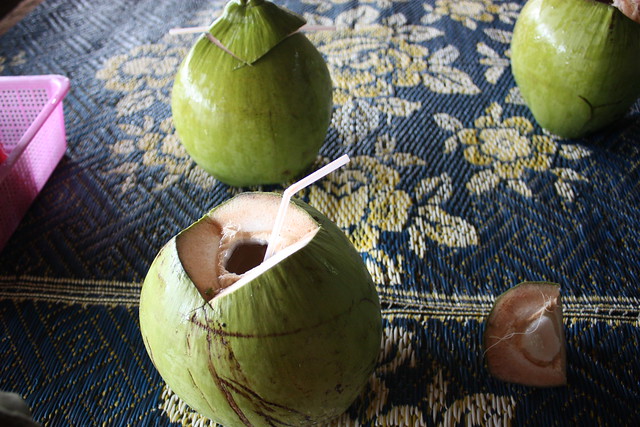
Emma soon arrived with the food, piping hot from the vendor at the end of the row of picnic tables. It was perfectly color coordinated, and all vegetarian – appropriate, given our surroundings. It seemed somehow wrong to eat an animal when we were surrounded by so many lovely ones. (I know that vegetarians and vegans feel that every day. But I was born with a strip of bacon in my mouth, so let’s consider this small step progress, shall we?)
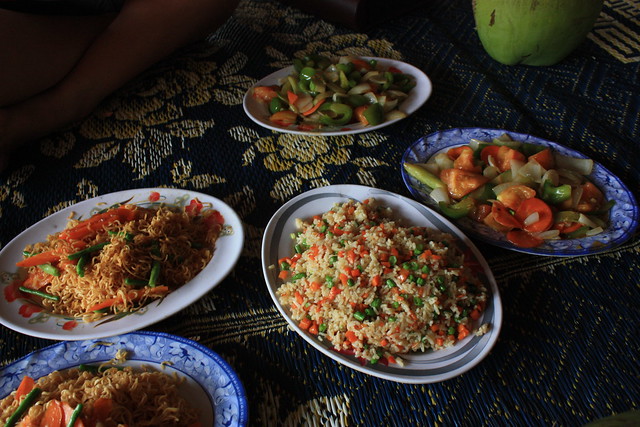
The rain subsided a little after lunch. Emma took us to see the lions and the bears, all rescued from the exotic pet trade.
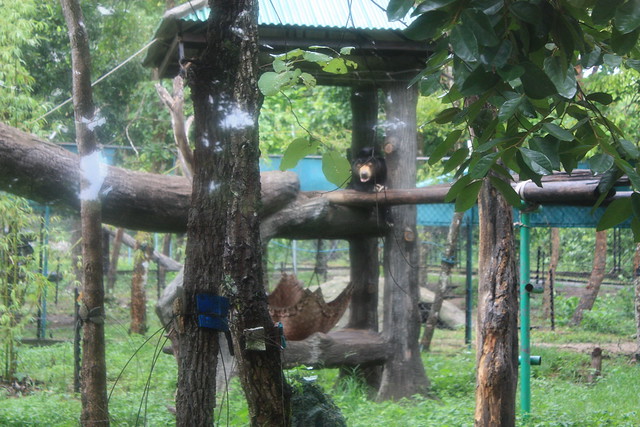
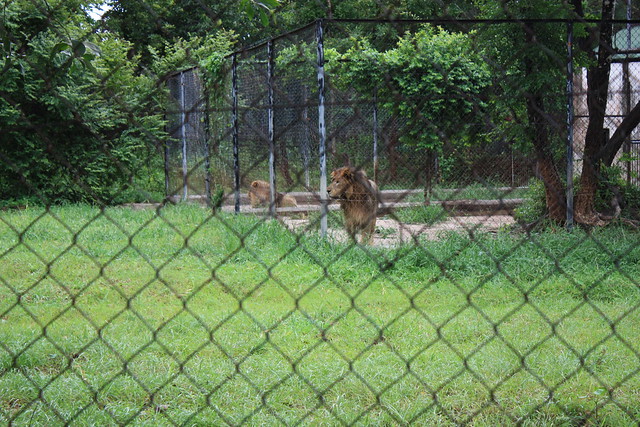
And more apes, many of which had been abused and mistreated, or kept as pets and fed inappropriate diets.
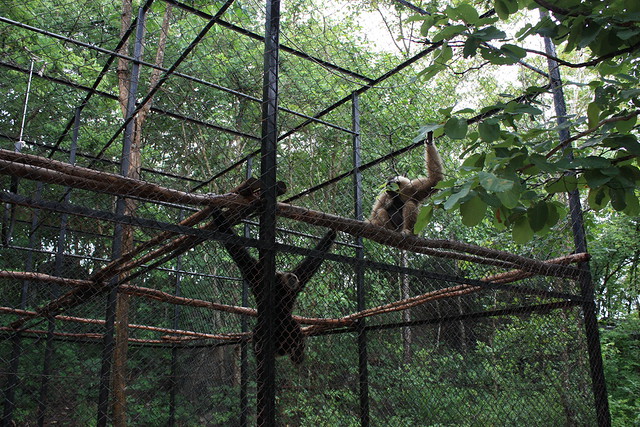
And countless other animals – so many I have trouble remembering them all.
We returned to the elephants to see Sakor (or was it Jamran? It is hard for me to tell elephants apart, I guess) having a check-up. His caretakers were examining his feet.
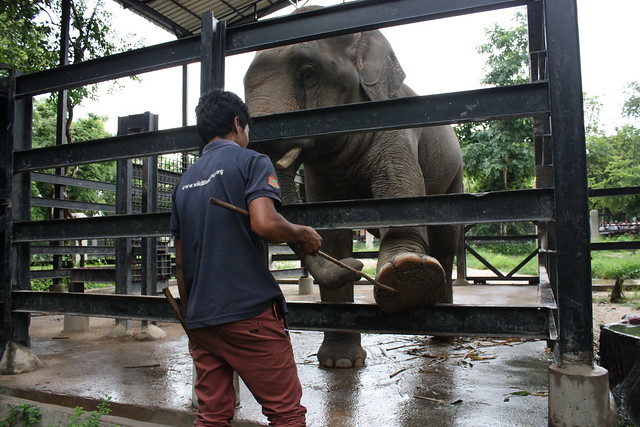
Have you ever seen the bottom of an elephant’s foot? Up until that point, I hadn’t, either.
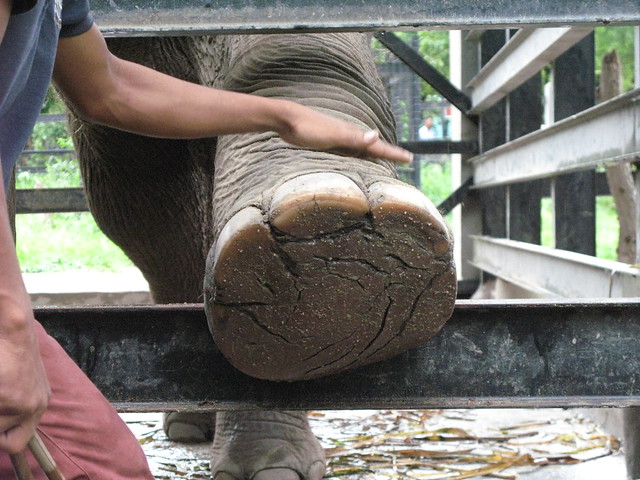
Photo courtesy of Nicci. Thanks, Nic!
Then we had one more afternoon walk with Lucky.
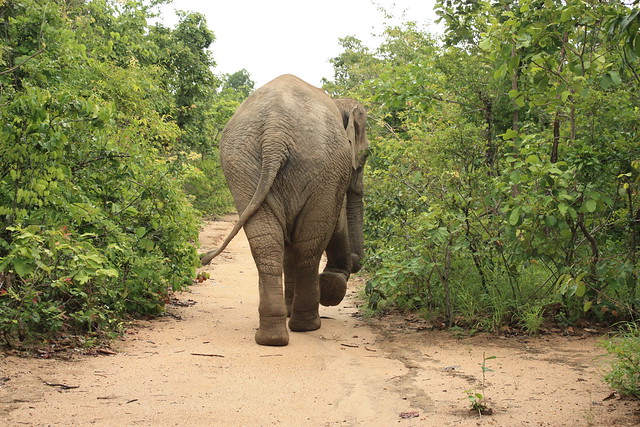
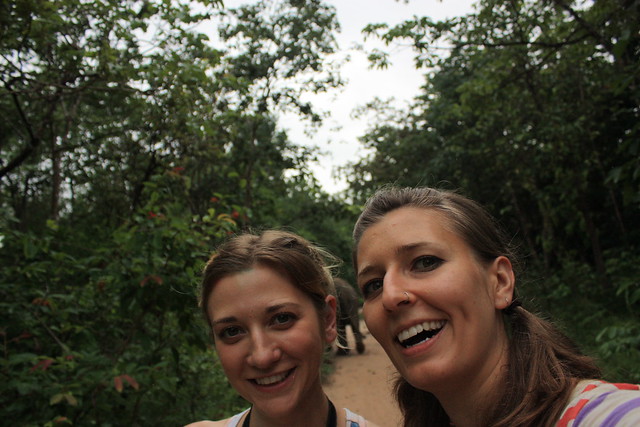
OMG. SELFIE WITH AN ELEPHANT BUTT.
And if the day had ended there, it still would have been magical and unforgettable. But it didn’t end there. No. It was the real-life equivalent of an amazing infomercial deal. It felt like every time we were amazed and overwhelmed, someone would scream, “WAIT, THERE’S MORE!”
And then there was more.
We still had to visit the nursery. There we saw the tiniest victims of the exotic pet trade. Some of them still had a chance for rehabilitation and release into the wild. Some of them didn’t. The latter group would spend their lives here, at the Center.

A snoozing civet cat.
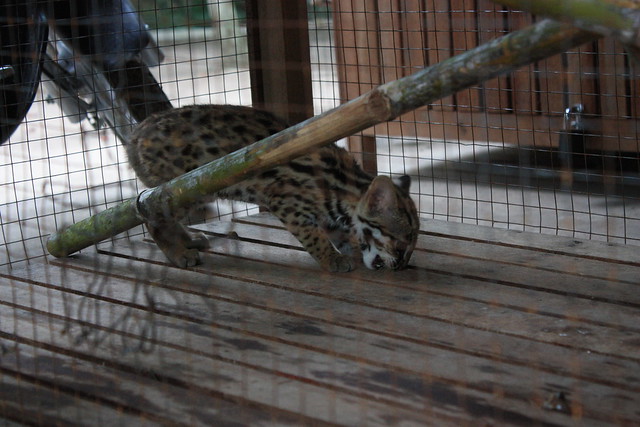
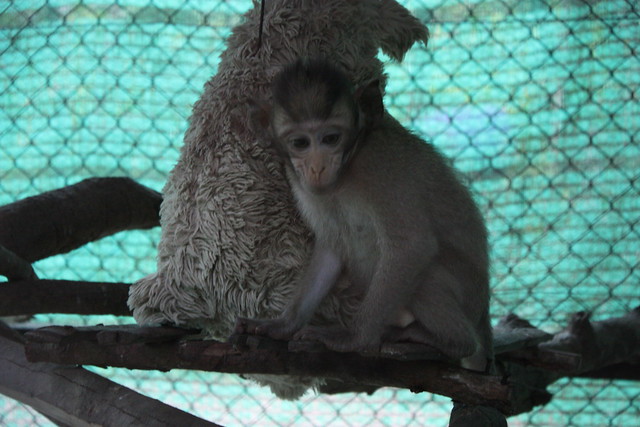
And finally, finally, it was time to see the monkeys.
For the record, monkeys scare me less than apes. Oh, what a difference a curly tail makes! They’d all been rescued from various places. One had been taught to smoke and drink as part of an act for tourists. Another was a pet that someone eventually turned over to the Wildlife Center.
Emma prepped us on what to do. She told us to take off all our jewelry (which for me included my nose ring – not an easy task to remove), and to empty our pockets. Even if there was a scrap of paper or candy wrapper, they’d find it. She advised us to not laugh – it sounds hostile to monkeys. Ditto with smiling – if you show your teeth, they take it as a sign of aggression.
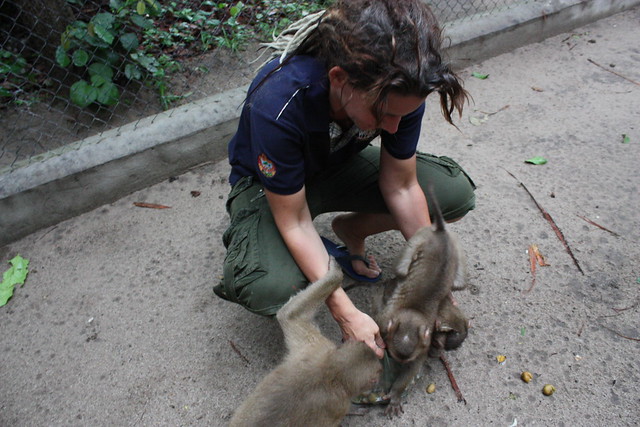
Emma, with some of the crew.
No smiling. No laughing. Right. Logically, I understand that. But have you ever had a monkey jump all over you looking for food?
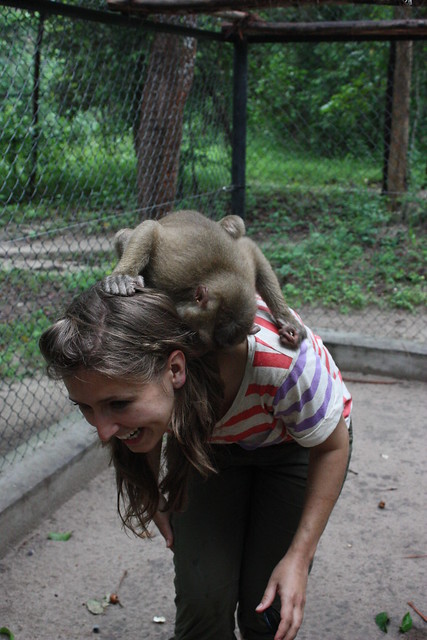
Baring my teeth? Check. Laughing? Check. Monkey on my back, trying to locate my jugular? Check.
IT IS VERY HARD TO NOT SMILE OR LAUGH WHEN SOMETHING ADORABLE AND FURRY IS MUGGING YOU.
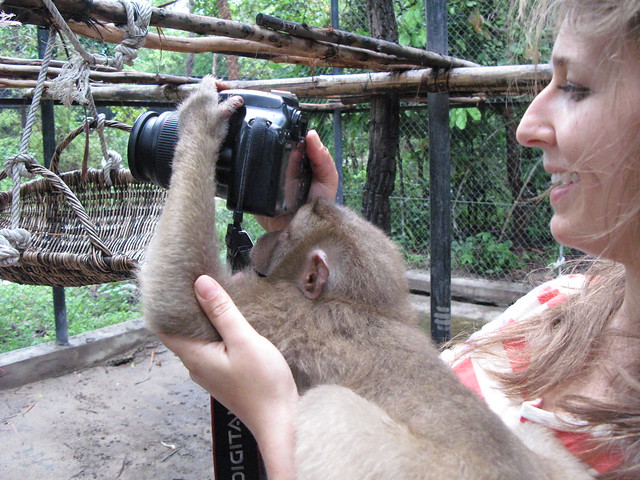
Oh, yeah – and he started looking through my camera lens, too.
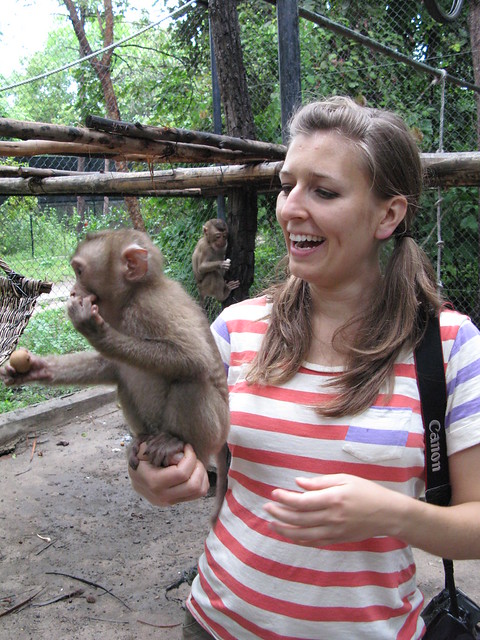
I kept forgetting the rules. I smiled. I laughed. It was a miracle I didn’t get us all mauled. One monkey did grab my lower lip. I quickly curled it inward. I think he was curious more than anything else.
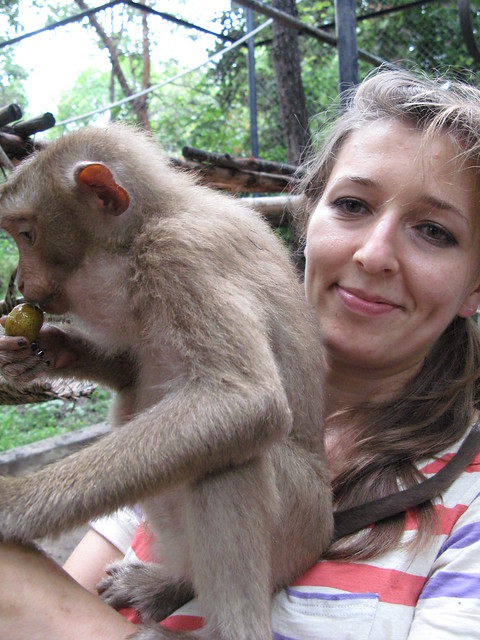
But hey, look! I eventually learned my lesson!
Nicci was waaay better at it than I was:
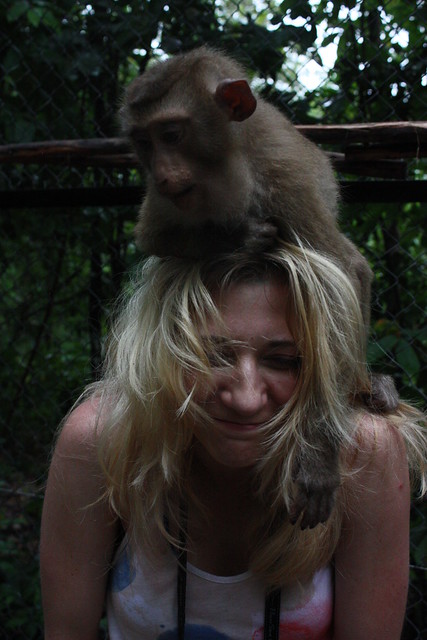
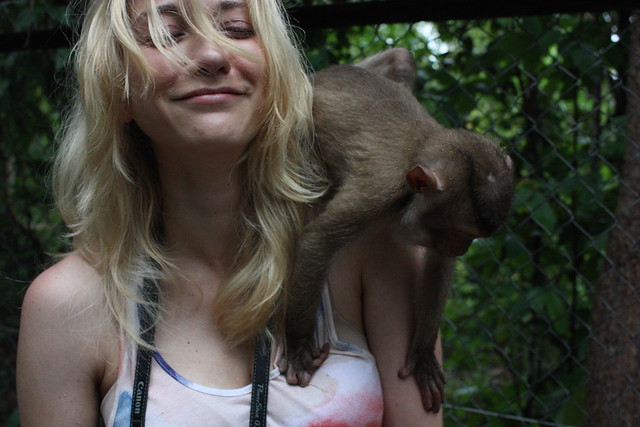
And then, then, after all that, Emma took us home. It felt like we were saying goodbye to friends – not just Emma, but Lucky, and Chhouk, and all the others.
When we got back to the hotel, Nicci and I chatted for a long while, trying to process everything that happened. We got to interact with these wonderful animals because humans had left them unable to live in the wild. It was a wonderful experience, but also an unsettling one.
Phnom Tamao Wildlife Rescue Center isn’t perfect. They need more resources, larger enclosures, more understanding from the Cambodian government. That it has to exist in the first place is a sad reality. But the people who work there are trying to make the world a better place. They are working tirelessly to fix what others have broken.
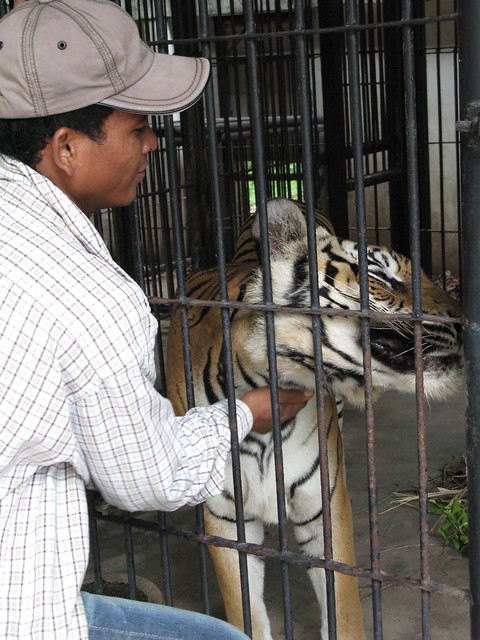
It may be easy to find flaws with the organization, but not with its mission.








